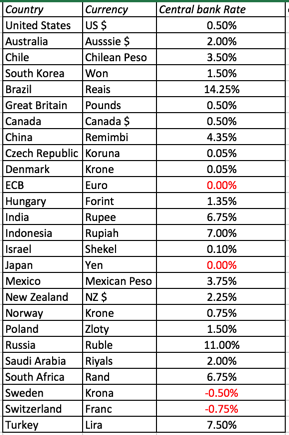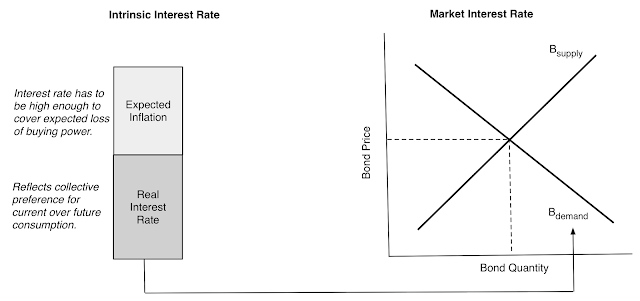From Musings On Markets:
In the years since the 2008 crisis, there is no question in finance that
has caused more angst among investors, analysts and even onlookers than
what to do about "abnormally low" interest rates. In 2009 and 2010, the
response was that rates would revert back quickly to normal levels,
once the crisis had passed. In 2011 and 2012, the conviction was that it
was central banking policy that was keeping rates low, and that once
banks stopped or slowed down quantitative easing, rates would rise
quickly. In 2013 and 2014, it was easy to blame one crisis or the other
(Greece, Ukraine) for depressed rates. In 2015, there was talk of
commodity price driven deflation and China being responsible for rates
being low. With each passing year, though, the conviction that rates
will rise back to what people perceive as normal recedes and the floor
below which analysts thought rates would never go has become lower. Last
year, we saw short term interest rates in at least two currencies
(Danish Krone, Swiss Franc) become negative and this year, the Japanese
Yen joined the group, with rumors that the Euro may be the next currency
to breach zero. While it has been difficult to explain the low interest
rates of the last few years, it becomes doubly so, when they turn
negative. I would be lying if I said that negative interest rates don't
make me uncomfortable, but I have had to learn to not only make sense of
them but also to live with them, in valuation and corporate finance.
This post is a step in that direction.
Setting the table
There are a handful of currencies that have made the negative interest
rate newswire, but it is worth noting that the rates that are being
referenced in many of these stories are rates controlled by central
banks, usually overnight rates for banks borrowing from the central
bank. In March 2016, there were two central banks that had set their
controlled rates below zero (Switzerland and Sweden) and two more (ECB
and Bank of Japan) that had set the rate at zero. (Update: The ECB
announced that it would lower its rates below zero on March 10.)

Note that these are central bank set rates and that short and long term
market interest rates in these currencies can take their own path. To
provide a contrast, consider the Japanese Yen and Euro, two currencies
where the central banks have pushed the rates they control to zero. In
both currencies, short term market interest rates have in fact turned
negative but only the Yen has negative long term interest rates
In a post from earlier this year,
I looked at long term (ten-year) risk free rates in different
currencies, starting with government bond rates in each currency and
then netting out sovereign default spreads for governments with default
risk. Updating that picture, the government bond rates across currencies
on March 9, 2016, are shown below:

Joining the Japanese Yen is the Swiss
Franc in the negative long term interest rate column. Why make this
distinction between central bank set rates, short term market interest
rates and long term interest rates? It is easier to explain away
negative central bank set rates than it is to explain negative short
term interest rates and far simpler to provide a rationale for negative
rates in the short term than negative rates in the long term. Thus,
there have been episodes, usually during crises, where short term
interest rates have turned negative, but this is the first instance that
I can remember where we have faced negative long term rates on two
currencies, the Swiss Franc and the Japanese yen, with the very real
possibility that they will be joined by the Euro, the Danish Krone, the
Swedish Krona and even the Czech Koruna in the near future.
Interest Rates 101
I am not a macroeconomist, have very little training in monetary
economics and I don't spent much time examining central banking
policies. Keep that in mind as you read my perspective on interest
rates, and if you are an expert and find my views to be juvenile, I am
sorry. That said, I have to process negative interest rates, using my
limited knowledge of what determines interest rates.
Intrinsic and Market-set Interest Rates
When I lend money to another individual (or buy bonds issued by an
entity), there are three components that go into the interest rate that I
should demand on that bond. The first is my preference for current consumption over future consumption, with rates rising as I value current consumption more. The second is expected inflation in the currency that I am lending out, with higher inflation resulting in higher rates. The third is an added premium for any uncertainty that I feel about not getting paid,
coming from the default risk that I see in the borrower. When the
borrower is a default-free entity, there are only two components that go
into a nominal interest rate: a real interest rate capturing the
current versus future consumption trade off and an expected inflation
rate.
Nominal Interest Rate = Real Interest Rate + Expected Inflation Rate
This is, of course, the vaunted Fisher equation. There is an alternate
view of interest rates, where the interest rate on long term bonds is
determined by the demand and supply of bonds, and it is shifts in the
demand and supply that drive interest rates:

How do you reconcile these two worlds?
To the extent that those demanding bonds are motivated by the need to
earn interest that covers the expected inflation and generate a real
interest rate, you could argue that in the long term, the intrinsic rate
should converge on the market set rate.
In the short term, though, as with any financial asset, there is a real
chance that the market-set rate can be lower or higher than the
intrinsic rate. What can cause this divergence? It could be investor
irrationality, where bond buyers overlook their need to cover inflation
and earn a real rate of return. It could be a temporary shock to the
supply or demand side of bonds that can cause the market-set rate to
deviate; this is perhaps the best way to think about the "flight to
safety" that occurs during every crisis, resulting in lower market
interest rates. There is one more reason and one that many investors
seem to view as the dominant one and I will address it next.
The Central Bank and Interest Rates
In all of this discussion, notice that I have studiously avoided
bringing the central bank into the process, which may surprise you,
given the conventional wisdom that central banks set interest rates.
That said, a central bank can affect interest rates in one of two ways:...MORE



